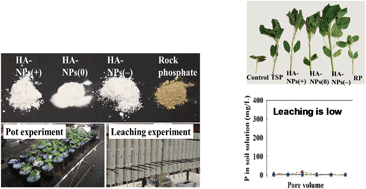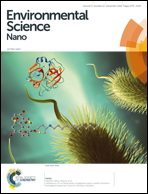Bioavailability and movement of hydroxyapatite nanoparticles (HA-NPs) applied as a phosphorus fertiliser in soils
Abstract
Hydroxyapatite nanoparticles (HA-NPs) have recently been proposed as a novel phosphorus (P) fertiliser that can provide increased efficiency and minimise adverse environmental impacts. In the present study, three types of HA-NPs differing in surface charge were synthesised and their benefit as fertilisers was assessed using sunflower (Helianthus annuus) in a glasshouse pot experiment for 35 d using two P-deficient soils (an Ultisol and a Vertisol). In addition, their mobility was examined using a column leaching experiment with sand as a control. The surface charge of the three HA-NPs was +22.1, −1.37 and −13.8 mV at pH 7 [hereafter denoted as HA-NPs(+), HA-NPs(0), and HA-NPs(−)], with an average particle size of 25.7 nm. In the Ultisol (pH 4.7), addition of triple superphosphate (TSP) or any of the three HA-NPs increased plant biomass by 6.4–11.6 times, with the HA-NPs(−) increasing fresh biomass the most (16.5-fold for the shoots and 8-fold for the roots). Rock phosphate (RP) marginally increased plant biomass (only by 1.5 fold). In the Vertisol (pH 8.2), none of the three HA-NPs or the RP significantly increased the plant growth, whereas TSP increased the fresh biomass by 28%. In the column leaching experiment, we found that although the overall mobility of P in both soils was low, the application of HA-NPs(−) in the Ultisol slightly increased the P mobility. Our results show that for the acid Ultisol, HA-NPs with altered surface charge may be a useful form of P fertiliser.



 Please wait while we load your content...
Please wait while we load your content...